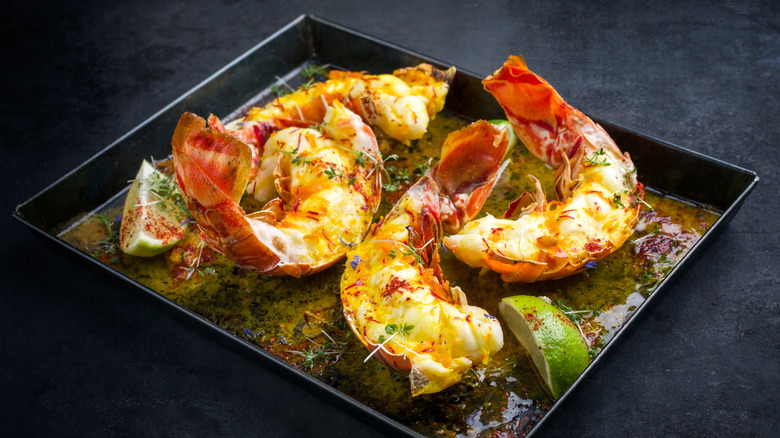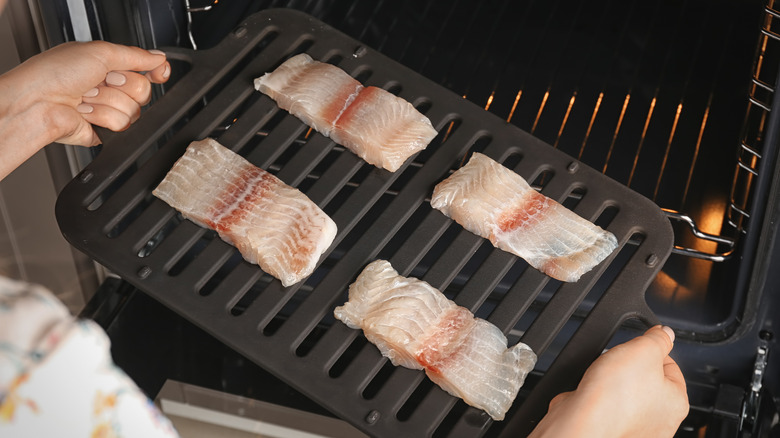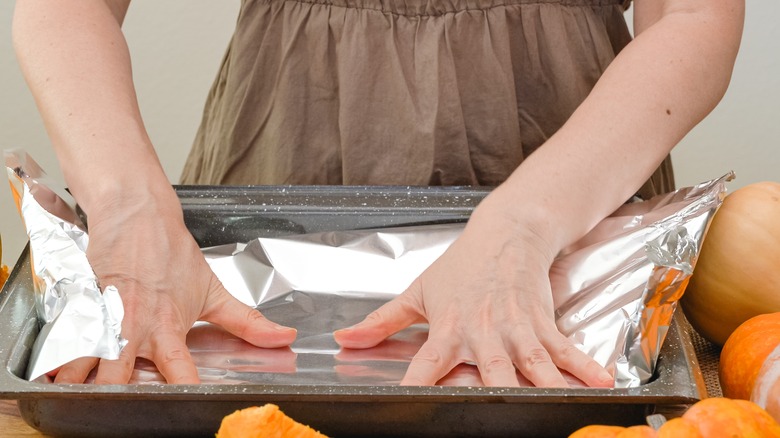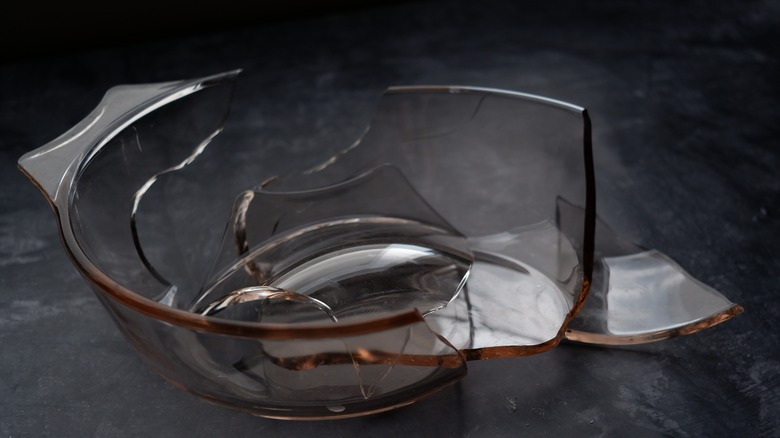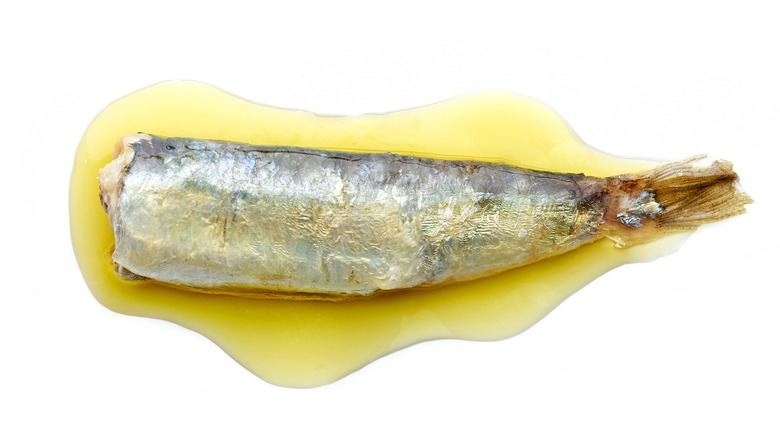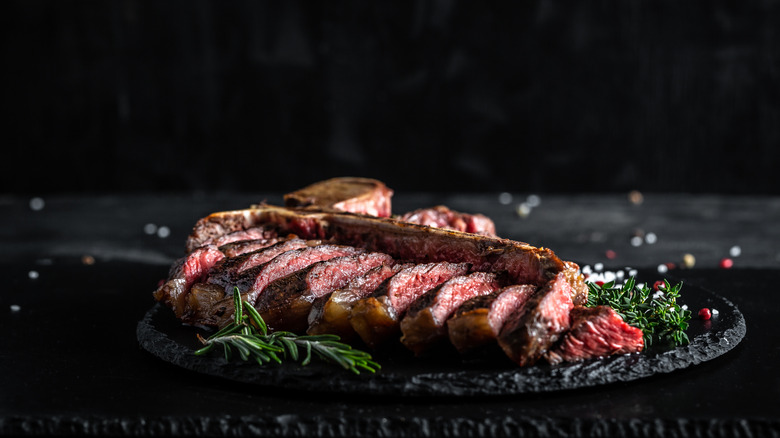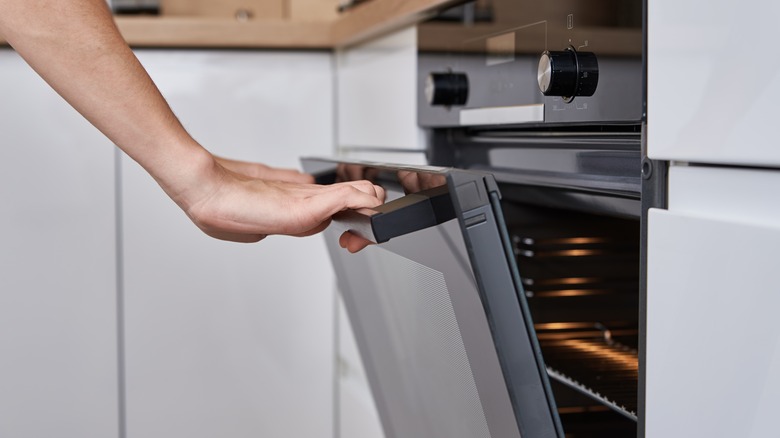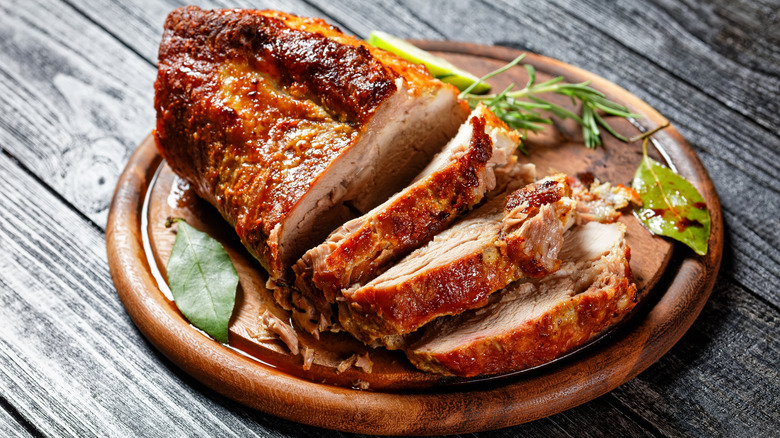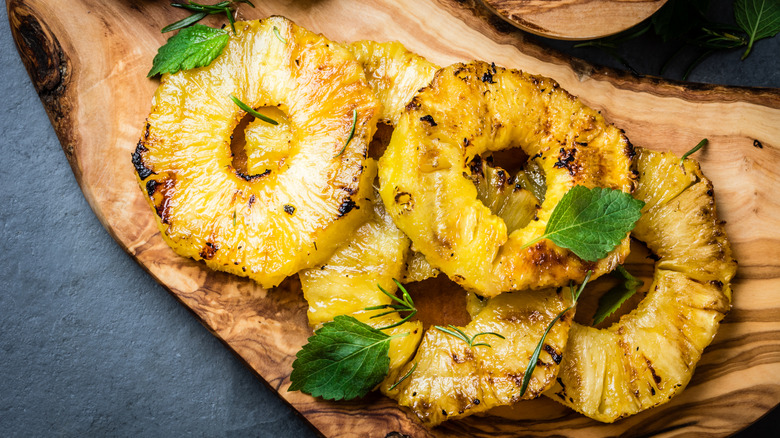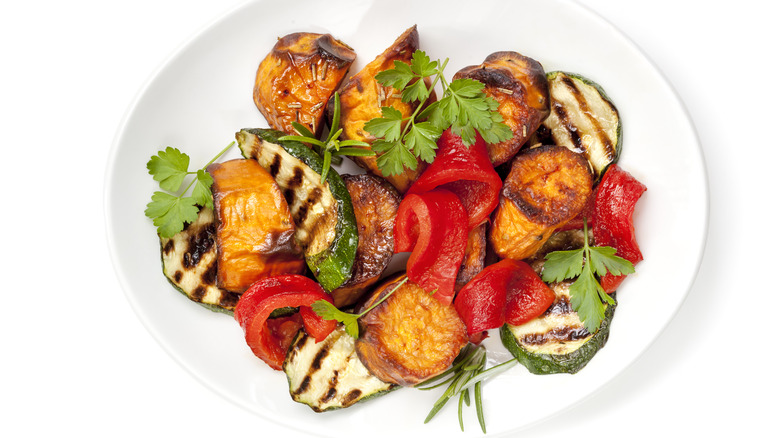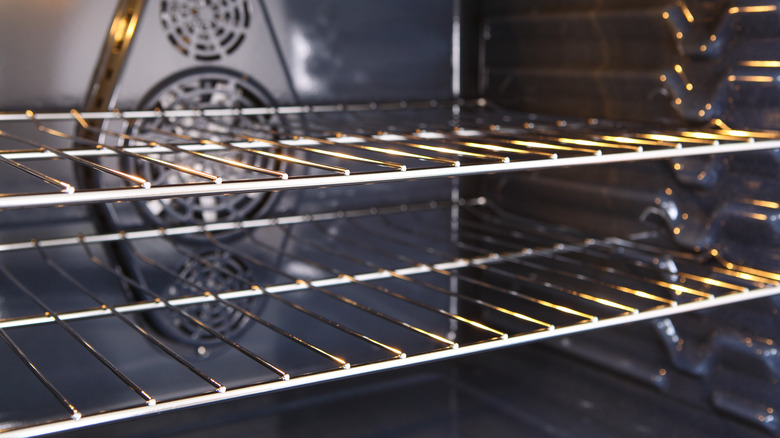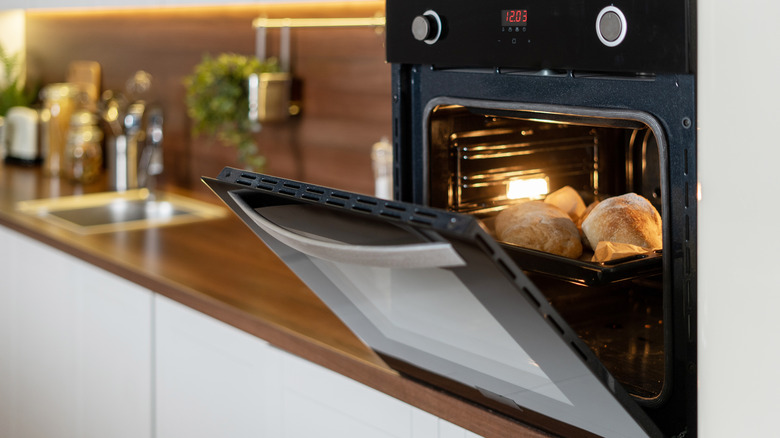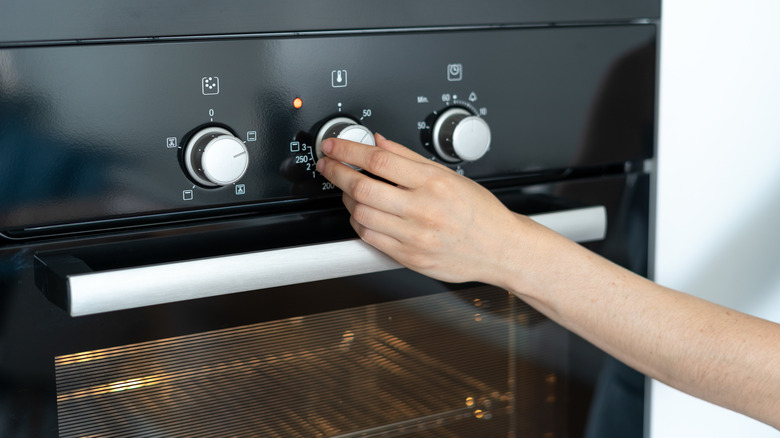12 Mistakes You Want To Avoid When Broiling Food
Broiling is a way to add flavor, seal in moisture, and make meals satisfyingly browned and crispy. Like grilling, it uses high heat from a single direction to powerfully sear and cook food. Unlike baking, where goods are heated up slowly and evenly as the air inside the oven is warmed, broiling involves cooking items from above at temperatures up to 550 degrees Fahrenheit. This intense blast of heat just a few inches from the dish is ideal for quickly creating a charred exterior and a juicy interior. Broiling is often reserved for foods such as red meat, chicken, fish, and vegetables. Entrées like a marinated London broil and lobster tails, appetizers like oysters and jalapeño poppers, and even grilled cheese all benefit from this cooking method. It also works well for browning the tops of dishes like cheesy casseroles and French onion soup.
Broiling is considered safe, but some may wonder how to achieve that flawless caramelized crust while fully cooking the inside of food or how to prevent the food from burning. No one wants to spend time in the kitchen just to ruin a perfectly prepped dish. To maximize your success, here are some mistakes you want to avoid when broiling food.
Not using a broiler pan
A broiler pan consists of a metal rack — or ridged grate with slots — that sits on a shallow baking vessel underneath. The oven's high heat causes fat to render, so the kitchen item is designed to hold the meat or other food out of the fat and juices, which drip down and collect at the bottom. The result is not just healthier meals, since extra grease is drained away, but the slots in the upper pan also increase the hot air's flow around the food, so you don't have to turn it as often while it cooks.
Some, but not all, ovens come with matching broiler pans. If you don't have one, you can use a cast iron skillet, which is especially suited to high heat. Another option is to use a baking sheet (designed to withstand hotter temperatures without distorting) and lay a rack over it to keep the food out of the drained fat. When using either of these kitchen items without a top or slotted grate, make sure you flip the food during cooking to evenly cook both sides since there won't be any airflow from below.
Not lining the pan before broiling
Have you ever baked something in the oven and then tried to clean the brown scorch marks or the burned crust from the bottom of the baking dish? Sometimes, not even a long soak will be enough to do the job. Broiling uses even higher heat, so the fatty burnt bits will blacken and stick to the pan even more. To prevent this, line the pan with aluminum foil first. If you're adding the lining to a broiler pan, use a knife to cut slots in it for the upper rack, so the airflow isn't blocked. A disposable aluminum pan is another option for easier cleanup.
For safety reasons, avoid using parchment paper when broiling; even though it's oven safe, it can burn when heated over 450 degrees Fahrenheit. Also, if you're tempted to use a pan with a nonstick coating like Teflon to save time cleaning up, don't. When heated to very high temperatures, the surface layer disintegrates and breaks down, producing toxic fumes. This applies to nonstick baking sheets and racks as well.
Using glass baking dishes
For safety reasons, don't make the mistake of using Pyrex or other oven-safe glass dishes for broiling. The original branded glassware, created in 1915, was made of sturdy borosilicate glass. It could withstand high-temperature changes of up to 300 degrees Fahrenheit without shattering. However, by the 1990s, the formula had changed. Today, Pyrex is made out of soda lime silicate glass, which makes the material shatterproof, but it can only handle temperature fluctuations of up to 99 degrees. Since a broiler can reach 550 degrees, introducing a room-temperature dish into that kind of environment will have potentially dangerous results.
Otherwise, using Pyrex in the oven for regular baking needs is okay. Regardless if it's the old or new version, the glassware is a good choice for the cooking method, as the interior will heat up more slowly and not reach the same high levels as broiling.
Broiling oily foods
If you've never used the broiler before, you'll find that the blast of high heat from one direction is a very different cooking experience from baking, and the closeness of the pan to the heat source brings a special safety consideration. It's a mistake to broil very oily foods, dishes covered in moist sauces and marinades, or meat that hasn't been trimmed of its extra fat. The grease vaporizes in the oven, and high temperatures can cause splattering. If the oily particles come in contact with hot oven surfaces, they can quickly catch fire. However, they will smolder before burning, so watch the broiler carefully and turn it off at any sign of smoke (via D'Artagnan).
In the event of an oven fire, immediately turn off and unplug the oven if it is safe to do so, and keep its door closed so the blaze can smother out. (Never use water to put out a grease fire.) Ensure the area is ventilated by opening a few windows, and call emergency services if the flames appear out of control (via Cleanup & Total Restoration).
Using overly moist seasoning
Seasoning food before cooking adds depth of flavor, and there's no reason to avoid it when broiling. Just be careful not to dress the dish with too much moisture or oil-based liquids, which can be a fire risk when placed just inches from an extremely hot heat source. You don't have to say goodbye to marinades, though. Simply pat the sides of the food dry before placing it on the pan to reduce the wetness. If you brush your meat, fish, or veggies with oil or butter before cooking, use a light hand so the fat doesn't pool at the bottom of the dish. Finally, be careful when using sweet marinades or sauces because the sugars will caramelize quickly. Use a brush to apply them to the food during the last few minutes of cooking instead.
Since broiling is best as a dry cooking method, rubs are a good alternative to marinades. Both dry rubs and marinades add serious flavor to roasted food, but the former contains no liquid; the chance of fat spattering and sparking in the oven will be reduced. They can be made with spices such as garlic or onion powder, dry mustard, cayenne pepper, salt, and Italian seasonings.
Not watching the oven like a hawk
The high temperature of a broiler is an excellent way to prepare meat and fish, but using such an intense method requires some caution. Because the roaster is so powerful, the food under it will cook quickly, usually in five to ten minutes. Although most broilers don't exceed 550 degrees, the unidirectional nature of the heat increases its potency.
It's a mistake not to watch the oven carefully during this time, so don't walk away! It only takes a few seconds for perfectly prepared food with a delightfully caramelized crust to turn into a black, charred, smoky mess. If you don't want to stand directly in front of the range, then set a timer (while staying in the kitchen, at least), especially if you're prone to forgetting you have things in the oven. Factoring in five minutes of preheating time and up to ten minutes to cook, the broiler should only be on for a maximum of fifteen minutes.
Another reason to watch the oven closely is so you can adjust certain foods over time. Move the pan to a lower oven rack if the dish darkens too quickly, or reduce the temperature if the broiler can be adjusted this way. If you don't have a broiler pan, flip the food every few minutes, or at least once halfway through, to get an even crust on the top and bottom.
Broiling thick cuts of meat
Because broiling is such a fast cooking method, it's ideal for thinner cuts of meat or those cut into small pieces, like with kabobs. Strip steaks, pork chops or medallions, pounded chicken breasts, fish fillets, and seafood are good choices. Just be careful not to leave the leaner options in the oven for too long, as they won't take as long to prepare as red meat. Even fruit and vegetables benefit from broiling.
That said, avoid cooking large cuts of meat in the broiler. The high heat will brown and finish the crust while the inside remains raw, so prioritize a different preparation method, like baking, for anything thicker than 1½ inches. If you left the broiler on long enough to cook it all the way through, the exterior would be burned and inedible. You can also use a combination of baking and broiling for a bigger cut of meat. If you have your heart set on a crispy exterior, bake first to cook the inside properly, and then place it under the broiler for the last two to three minutes to sear the surface.
Not making broiled desserts
Broiled desserts? Don't leave them out of your repertoire. Unique sweets like broiled fruit are an easy way to impress. Some people may be familiar with grilling produce like pineapples and peaches, and the reason they turn out so delicious is that their natural sugars will caramelize when cooked this way. The intense heat of a broiler cooks food the same way that grilling does, so why not try it with fruit too?
Try broiling slices of mango, pears, or apricots, or place halves of banana, figs, and grapefruit under the heat. The fruit can be cooked alone or with other ingredients. This recipe for broiled pluots calls for sugar and cinnamon to be sprinkled over them before broiling, adding a little extra sweetness and spice. Pair the fruit with a cold dessert like vanilla ice cream for a delightful temperature contrast.
Perhaps the most well-known broiled dessert is crème brûlée. A soft baked dessert made with cream, egg yolks, and sugar, the top is famously burned with a food torch before serving. If you don't have this kitchen tool handy, after baking the custard in molds, place them under the broiler to brown the tops. Just keep an eye on them so they don't burn or blacken.
Not broiling veggies
Grilled vegetables are a frequent feature of backyard barbecues, with recipes for them abound. Although broiling is a lesser-known cooking method, it would be a mistake not to try it with veggies too. It's an excellent way to create deeper flavors and a delicious caramelized crust on foods like eggplant, peppers, zucchini, fennel, onions, and sweet potatoes. Broiled vegetables are similar to their grilled counterparts, which are also cooked on a rack just inches from a very hot heat source. If you're used to grilling veggies, you can utilize some of the same techniques.
Since broiling is a dry cooking method, the moisture in veggies should be reduced before being placed in the oven. Lightly salt vegetables half an hour before broiling to allow extra water to seep out. This is especially important when preparing produce with higher water content, like eggplant and zucchini. Like larger cuts of meat, pre-baking is also handy for more thickly sliced veggies or firmer ones like butternut squash and celery root. The broiler alone won't cook the insides enough before the outside burns, so baking will partially cook the pieces; they can then be placed under the broiler for a few minutes to achieve a crispy crust.
Using the wrong oven rack position
A couple of inches of distance from an intense heat source can mean the difference between a delightfully caramelized crust or a torched mess, so don't choose the wrong oven rack position. The roaster is usually on the oven's roof, so a good starting point is to position food three to five inches below the broiler. However, it's a good idea to check your stove's manual to see what the manufacturer recommends for the kind of meal you're broiling. The closer the dish is, the quicker it will cook and the browner it will become, but there's also more of a chance that it could burn or that splattering oils could cause a fire (per Consumer Reports).
If the food is farther away from the broiler, the heat won't be as intense and will give the inside more time to cook before the crust is browned. Slightly thicker cuts of meat can be placed farther away from the broiler for this reason, but for 1½ of thickness or more, it is safer to pre-bake the slab first and sear the surface under the roaster at the end. If a dish is browning too quickly, move the pan to a lower rack position to prevent burning. Likewise, if it's taking longer than what the recipe indicates to cook a dish, move it closer to the broiler.
Not opening (or closing) the oven door
Some broilers can operate with the door slightly open (at about four inches or so) or closed — though not all ranges allow this, so check the information provided by your stove's manufacturer first. Broiling one way or the other can make a difference in how the final dish turns out.
Increased airflow is one reason to keep the oven door open; this facilitates even cooking, as the hot air will cook every side of the dish it can reach, not just the top. The effect will be enhanced using a broiler pan with a grate or slots. This also helps ensure the oven won't overheat. Open-door broiling is better for short cooking times, such as when preparing thin cuts of meat, because as the hot air escapes, the roaster is forced to stay on at maximum power.
On the other hand, keeping the oven door closed is ideal when broiling on low (for ovens with an adjustable temperature setting) for longer periods, such as when cooking thicker cuts of meat.
Using the wrong temperature
Steer clear of using the wrong settings when broiling food. Some ovens have the option to control the broiler's temperature, but most roasters can simply be switched on and off. Adjustable settings are usually high (500-550 degrees Fahrenheit), medium (450 degrees Fahrenheit), and low (400 degrees Fahrenheit). Even if the only options are on and off, the temperature can be manipulated in other ways, such as slightly opening or closing the oven door or choosing a higher or lower rack position for your food.
Preheating is another important way to control the temperature when broiling, and it's especially recommended for gas ovens, which have a less even heat source. Turn the broiler on and let the range preheat for up to five minutes with the pan. This way, the heat from the hot surface will warm the underside of the food while the broiler sears the top. You don't want to leave the roaster on for more than 15 minutes when factoring in cooking time, so keep the preheat brief.
Higher temperatures are used for broiling thin meats and thinly sliced vegetables, creating a crispy, scorched crust while cooking the inside perfectly. A lower temperature will give thicker meats like chicken breasts more time to cook on the inside before the outside gets burned.
